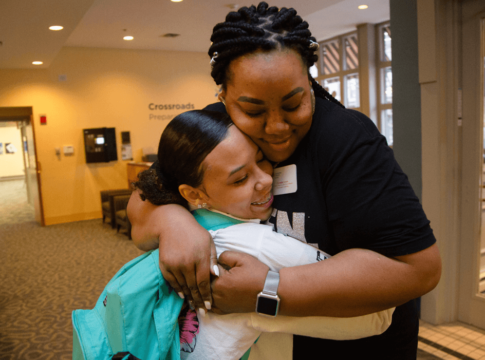 A Smarter Charter: Finding What Works for Charter Schools and Public Education
A Smarter Charter: Finding What Works for Charter Schools and Public Education
by Richard D. Kahlenberg and Halley Potter
Teachers College Press, 2014, $30.95; 240 pages.
As reviewed by Nelson Smith
Albert Shanker, former president of the American Federation of Teachers, was a towering figure in the political history of 20th-century education. In a prescient speech at the National Press Club in March 1988, he outlined his vision of a new kind of public school, one that would spur innovation by letting groups of teachers form autonomous units within other public schools. They would have the freedom to try doing things differently, and if their methods worked, other teachers would adopt them.
It was classic Shanker: smart, shrewd, down-to-earth, ahead of the curve—and well worth reading today (the full text is available at www.reuther.wayne.edu/files/64.43.pdf). He touched nearly all the bases we associate with what came to be called charter schools, from public funding to parent buy-in to accountability for outcomes. Because of this talk and his subsequent if short-lived advocacy, Shanker is often credited with conceiving the very concept of charters, although he drew on work published more than a decade earlier.
In A Smarter Charter: Finding What Works for Charter Schools and Public Education, Richard D. Kahlenberg (author of the excellent Shanker biography Tough Liberal) and his Century Foundation colleague Halley Potter (a former teacher at Two Rivers Public Charter School in D.C.) weigh today’s charter movement against Shanker’s vision and find it too market-driven, too willing to tolerate racial segregation, and overall, disappointing. But they think it can be salvaged by following the good examples of schools they profile in the absorbing and instructive latter half of the book.
First, though, they explain what’s wrong in charterland, taking a consistently glass-half-empty view of the movement’s progress and largely missing Shanker’s central point.
While it touches many bases, the book revolves around two paramount concerns: the absence of “teacher voice” and the lack of student diversity in many charters.
Voice
“Voice” is defined here as “formal mechanisms in a school for teachers to participate in decisions about instruction, organizational issues, and workplace conditions,” which is not a bad way of stating a goal that all charters should pursue. Charters profiled here have followed through in different ways, from the flat, empowering organizational structure of California’s High Tech High to teacher-driven networks like Minnesota’s EdVisions Co-op. But these are seen as exceptions to the rule, a view that undervalues the efforts made by thousands of charter schools to develop more collaborative models of work.
Despite pervasive references to Shanker, the authors don’t demand that charters unionize. In fact, they note that only 12 percent of charters are unionized, and just 4 percent by choice; the rest are required to do so by state laws. But instead of asking why that is, and exploring why teachers compete for charter jobs with at-will agreements or one-year contracts, they write of union-busting tactics at several charters, see low rates of unionization as a “cause for concern,” and wind up recommending that state laws provide an automatic union vote in the first year of each charter.
Are tough working conditions in charters leading to an “epidemic” of teacher turnover? Kahlenberg and Potter cite an annual departure rate of 24 percent for charter teachers, compared to less than 12 percent in traditional public schools. But their data are now 10 years old, and newer federal numbers tell a different story. Charter teachers surveyed in 2011–12 were actually changing schools or leaving teaching at the somewhat higher annual rate of 28.8 percent. But the share of district school teachers “moving” or “leaving” had jumped to 25.6 percent by the same year. So perhaps there’s a teacher turnover “epidemic” in public education, but it’s apparently not driven by the Dickensian conditions of charter schools.
Diversity
Many charter schools, some profiled here, strive to achieve racial and socioeconomic diversity through outreach, location, and other means. And the authors provide some strong ideas for nurturing such efforts, from allowing interdistrict enrollment to assuring transportation funding (a hearty yes to that one).
But charter founders tend to go where the need is, which often means setting up shop in racially concentrated inner-city neighborhoods. They believe that the best way to remedy inequality is to assure that their students get a first-rate education. For them, that is the highest priority.
While conceding the nobility of these motives, Kahlenberg and Potter simply don’t buy the approach. They find it “astonishing” that 43 percent of black charter-school students attend schools where 99 to 100 percent of students are minorities (compared to 15 percent of black students at traditional public schools where that is the case). Reviewing national and city-level charter research, they note that studies repeatedly produce strong results for minority and low-income students, but then don’t connect the dots. Inner-city parents are signing their children up for charter lotteries because the schools are getting results for kids like theirs. Those parents don’t seem to share the authors’ belief that their children can’t learn well if they’re not sitting alongside affluent white kids.
Charter schools were not set up, as the authors assert, to be “a force for desegregation,” admirable as that goal is. Racial integration is simply not mentioned as a statutory purpose in state charter laws. And let’s be clear: although Shanker later objected to Afrocentric or religiously based charters, his Press Club comments were limited to saying that the proposed schools-within-schools would have student populations resembling that of the school in which they were located. This is quite different from the authors’ contention that today’s charters should “aspire in most cases to reflect the socioeconomic and racial makeup of a metropolitan region.”
In this passage there’s an echo of studies by the Civil Rights Project (CRP), on whose work the authors regrettably rely. The project’s 2010 study of “re-segregation” in charter schools has been roundly and properly criticized for comparing the racial composition of inner-city charters (e.g., Flatbush) with those of broad metropolitan areas (e.g., New York City plus parts of Long Island and New Jersey). Kahlenberg and Potter acknowledge the CRP’s methodological problems, but dig the ditch deeper by citing one article that appeared in this journal and eviscerated the CRP’s study (see “A Closer Look at Charter Schools and Segregation,” check the facts, Summer 2010) and a 2010 study looking at racial enrollment patterns among charter schools managed by for-profit management organizations, which represent just 12 percent of the charter sector nationally.
While praising individual schools that have been created to serve certain groups ill-treated in traditional systems, the authors see them collectively as outposts of a movement driven by market competition to seek out “niche” groups. It’s an absurdly overbroad category, taking in everything from the Hmong immigrants who attend charters in Minnesota to the legions of students “at-risk” (according to a variety of definitions) who attend charters that are specifically encouraged to open by numerous state charter laws. (Indeed, one subchapter bears the inflammatory title, “SEGREGATION BY DESIGN FOR MARGINALIZED GROUPS.”)
Charter Achievement
All of this might be more tolerable, they say, if it were true that “achievement trumps diversity,” the banner under which nondiverse charters supposedly march. The authors concede that a number of national and city-level studies show relatively strong performance for disadvantaged youth in charters, but come to rest on the familiar refrain that charter students do about the same as those in other public schools. The two nationwide charter studies published by CREDO at Stanford, in 2009 and 2013, are trotted out to verify this (although both show stronger performance for low-income charter students than for their peers in district-managed schools). But side by side, the two studies demonstrate something important and often overlooked: in four years the national movement produced significant gains in overall sector performance. Kahlenberg and Potter downplay the power of this finding because it was driven largely by closures of failing charters. But closing weak schools is an essential ingredient of the charter model, a point of leverage largely absent in traditional districts. As CREDO’s report said of the 2013 results: “Moving the needle for 2 million students is no small feat.”
What Would Al Do?
Reading Shanker’s speech today, one is struck by the long opening sequence in which he bluntly indicts the existing system. “We’ve got the same schools today that we had 100 or 200 years ago,” he says. Eighty percent of students “do not learn well in traditional settings.” (Imagine hearing this candor from any of today’s counter-reformistas!) So why did he pivot from these caustic observations to a proposal for something like charter schools?
Shanker saw chartering as a way to create perpetual-motion reform machines that would change school systems from within, a response to the necessary but slow-moving impact of the top-down standards movement. The teachers would have a guarantee “to be left alone for five to ten years” to insulate them from the vagaries of school board politics and revolving-door superintendencies. They’d keep track of what they did and report on what worked and what didn’t. If things went well, the enterprise would become a totally autonomous school within the district. While “teacher voice” was a key driver in Shanker’s career, and while he thought the proposal would only work within a collective bargaining context, “voice” per se was not the point. He wanted to create, in contemporary parlance, a disruptive force. And he wanted it now, even if some union locals weren’t ready for it: “I do not believe that all the conditions have to be right throughout the system in order to do the possible.”
When legislators began writing charter laws in what are now 42 states and D.C., they often exempted charters from collective bargaining, deeming the union contract itself as a straitjacket. Rather than incubating innovation through small groups within existing schools, they called for full-fledged, freestanding schools. In decoupling these new schools from unions, however, the laws also severed the connections between charter and district teachers, the circuitry on which Shanker saw innovation flowing.
Local school districts now constitute 90 percent of charter school authorizers and could have fostered the kind of cross-fertilization Shanker envisioned, but they’ve tended instead to treat charters as distant cousins. Cooperation and mutual learning have been built through individual initiatives, including projects profiled in the book, such as the Capital Teaching Residency program launched by E. L. Haynes and KIPP charters in the nation’s capital. Only in recent years have we seen serious, broad-scale efforts at cooperation, such as the charter/district compacts now sponsored in 21 cities by the Bill & Melinda Gates Foundation. And innovations incubated in the charter sector, like the online lesson-sharing platform LearnZillion, are becoming available to teachers in any kind of school.
Albert Shanker died in 1997 and did not live to see the next turns in the road for charter schools. He had castigated for-profit charter managers, but the year after his passing the first nonprofit charter management network, Aspire Public Schools, was founded by a former California district superintendent named Don Shalvey. The same year, two Houston teachers won a charter to start something called the Knowledge Is Power Program, or KIPP. In the late ’90s began the ongoing stream of studies showing that charters have a particular power to reach kids in poverty and close achievement gaps. And in 2014, a network of New York City charters run by one Eva Moscowitz—talk about a “Tough Liberal!”—was turning in astonishing academic results and beating the pants off upstate suburban kids.
Would Shanker have dismissed the charter movement over questions of diversity or teacher voice? He’d be fighting for these things and surely would be ramping up the effort to organize more charter schools, but he’d also be visiting them and talking with students and teachers to find out what was making them tick. And he might have come up with yet another magnificent speech, this time resolving some of the knots he couldn’t have foreseen 27 years ago.
Nelson Smith is senior advisor to the National Association of Charter School Authorizers. The views expressed here are his own.





